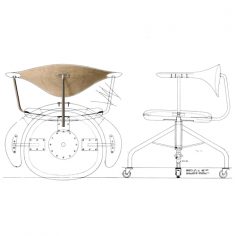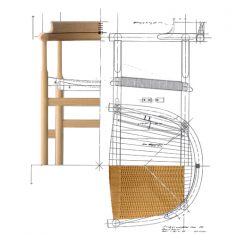In 1993 work began on the renovation and conversion of the water tower in Tønder into a museum to house the designs of Hans J. Wegner who was born in the town in 1914. The museum opened on 12 August 1995 with a collection that consists of 37 of the designers chairs donated to the town by Hans and Inga Wegner. These designs are illustrated below in date order and represent Wegner’s lifetimes study on the design of the chair. You can read more on the history and details of each design by following the link to read more.
FH4283 Chinese Chair (1943)
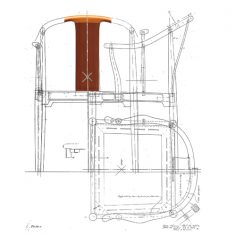
 During the time of occupation Fritz Hansen approached Wegner for suggestions using Danish beech for their bent-wood-production. The results are The Chinese Chairs of which two go into production (FH 4283 and FH 1783 – later as PP 66 at PP Møbler). read more>>
During the time of occupation Fritz Hansen approached Wegner for suggestions using Danish beech for their bent-wood-production. The results are The Chinese Chairs of which two go into production (FH 4283 and FH 1783 – later as PP 66 at PP Møbler). read more>>
J16 Rocking Chair (1944)

 1944 was a pivotal and very productive year for Wegner in which he produced the Fish Cabinet, Peter’s Chair and Table, the China Chair and his second rocking chair, J16. read more>>
1944 was a pivotal and very productive year for Wegner in which he produced the Fish Cabinet, Peter’s Chair and Table, the China Chair and his second rocking chair, J16. read more>>
PP66 Chinese Chair (1945)
 In 1943 Wegner was asked for help by furniture producer Fritz Hansen, who had been importing and trying to fabricate light, moulded wooden furniture. Because of the war it had become difficult to import furniture, as well as the timber required for the company’s own furniture production. read more>>
In 1943 Wegner was asked for help by furniture producer Fritz Hansen, who had been importing and trying to fabricate light, moulded wooden furniture. Because of the war it had become difficult to import furniture, as well as the timber required for the company’s own furniture production. read more>>
CH410 Peter’s Chair (1945)
 When Børge Mogensen asked his good friend Hans J. Wegner in 1944 if he would be godfather to his son, Peter, it also marked the origin of one of the most famous pieces of Danish children’s furniture ever to see the light of day – the chair and table designed by Weegner the following year are named after Mogensens son, Peter. read more>>
When Børge Mogensen asked his good friend Hans J. Wegner in 1944 if he would be godfather to his son, Peter, it also marked the origin of one of the most famous pieces of Danish children’s furniture ever to see the light of day – the chair and table designed by Weegner the following year are named after Mogensens son, Peter. read more>>
PP550 The Peacock Chair (1947)

 The war years in Århus had been educational for Wegner, but in many ways they had also been difficult. When the Second World War ended there was no doubt he wanted to move back to Copenhagen where, among other things, he had access to Johannes Hansen’s workshop. read more>>
The war years in Århus had been educational for Wegner, but in many ways they had also been difficult. When the Second World War ended there was no doubt he wanted to move back to Copenhagen where, among other things, he had access to Johannes Hansen’s workshop. read more>>
PP105 Easy Chair (1947)
 The current PP105 dated 1970, has undergone very few changes compared to the 1947 model to which it relates. It is a comfortable armchair that encourages and supports an upright posture and comes quipped with seat and back cushions upholstered in fabric or leather.
The current PP105 dated 1970, has undergone very few changes compared to the 1947 model to which it relates. It is a comfortable armchair that encourages and supports an upright posture and comes quipped with seat and back cushions upholstered in fabric or leather.
The chair’s height makes it especially easy for the elderly with less strength in their legs and back to sit down and get up from. read more>>
PP501The Round Chair (1949)
 The Round Chair attracted little notice from the Danish media when Wegner exhibited it at Copenhagen’s Cabinetmaker Guild Exhibition in 1949. Later, in a letter to journalist/writer Henrik Steen Møller, Wegner had this to say about it: ‘As for my round chair, The Chair, there wasn’t a word in the Danish newspapers.’ But all of this was to change when news of the exhibition reached the American press, thanks to architect Viggo Steen Møller, the editor of the periodical, Dansk Kunsthåndværk (Danish Arts & Crafts), who served as intermediary. read more>>
The Round Chair attracted little notice from the Danish media when Wegner exhibited it at Copenhagen’s Cabinetmaker Guild Exhibition in 1949. Later, in a letter to journalist/writer Henrik Steen Møller, Wegner had this to say about it: ‘As for my round chair, The Chair, there wasn’t a word in the Danish newspapers.’ But all of this was to change when news of the exhibition reached the American press, thanks to architect Viggo Steen Møller, the editor of the periodical, Dansk Kunsthåndværk (Danish Arts & Crafts), who served as intermediary. read more>>
PP512 The Folding Chair (1949)
 In 1929 the modernistic architect Mies van der Rohe exhibited his iconic ‘folding chair’ in the German Pavilion at the Barcelona World’s Fair. It was made of steel, and while unable to fold since its crosspieces were welded fast, the ‘folding-chair principle’ was clearly evident in the chair’s construction. read more>>
In 1929 the modernistic architect Mies van der Rohe exhibited his iconic ‘folding chair’ in the German Pavilion at the Barcelona World’s Fair. It was made of steel, and while unable to fold since its crosspieces were welded fast, the ‘folding-chair principle’ was clearly evident in the chair’s construction. read more>>
PP503 The Chair (1950)
 The Round Chair attracted little notice from the Danish media when Wegner exhibited it at Copenhagen’s Cabinetmaker Guild Exhibition in 1949. Wegner later wrote to journalist/writer Henrik Steen Møller: ‘As for my round chair, The Chair, there wasn’t a word in the Danish newspapers.’ But all of this was to change when news of the exhibition reached the American press, thanks to architect Viggo Steen Møller, the editor of the periodical, Dansk Kunsthåndværk (Danish Arts & Crafts), who served as intermediary. read more>>
The Round Chair attracted little notice from the Danish media when Wegner exhibited it at Copenhagen’s Cabinetmaker Guild Exhibition in 1949. Wegner later wrote to journalist/writer Henrik Steen Møller: ‘As for my round chair, The Chair, there wasn’t a word in the Danish newspapers.’ But all of this was to change when news of the exhibition reached the American press, thanks to architect Viggo Steen Møller, the editor of the periodical, Dansk Kunsthåndværk (Danish Arts & Crafts), who served as intermediary. read more>>
CH24 The Wishbone Chair (1950)
 The Wishbone Chair designed by Wegner for industrial production is his most commercially successful design. Also known as the Y Chair, the Wishbone Chair has been produced for over sixty years by its original manufacturer, Carl Hansen & Son. read more>>
The Wishbone Chair designed by Wegner for industrial production is his most commercially successful design. Also known as the Y Chair, the Wishbone Chair has been produced for over sixty years by its original manufacturer, Carl Hansen & Son. read more>>
PP19 The Papa Bear Chair (1950)
 After having received the Lunning Prize in December 1951, Wegner was given a photo spread in the Danish national daily newspaper, Politiken. Here he can be seen concentrating on forming a chair out of Plasticine – a material he often used when making models of upholstered furniture. The chair was the Teddy Bear Chair. He had actually designed it the year before, but the manufacturer, AP Stolen, only began producing it in 1951. read more>>
After having received the Lunning Prize in December 1951, Wegner was given a photo spread in the Danish national daily newspaper, Politiken. Here he can be seen concentrating on forming a chair out of Plasticine – a material he often used when making models of upholstered furniture. The chair was the Teddy Bear Chair. He had actually designed it the year before, but the manufacturer, AP Stolen, only began producing it in 1951. read more>>
PP225 The Flaghalyard Chair (1950)
 Wegner received not only both his national and international breakthrough in 1949-50 with the design of his classic Round Chair. He also experimented with new materials in two unusually big chairs. Firstly, he tried out moulded plywood in a triple-shell easychair, and then steel in the Flag Halyard Chair. read more>>
Wegner received not only both his national and international breakthrough in 1949-50 with the design of his classic Round Chair. He also experimented with new materials in two unusually big chairs. Firstly, he tried out moulded plywood in a triple-shell easychair, and then steel in the Flag Halyard Chair. read more>>
CH23 Dining Chair (1950)
 CH23, a dining room chair, was one of the first pieces of furniture Wegner designed for Carl Hansen & Son in 1951 after having entered into a binding agreement the previous year. It was first presented at the Fredericia Furniture Fair alongside CH25, an the easy-chair variant of CH23. CH25 was a fixed, more industrial version of the more sophisticated Folding Chair with woven cane (PP512) Wegner had designed in 1949. read more>>
CH23, a dining room chair, was one of the first pieces of furniture Wegner designed for Carl Hansen & Son in 1951 after having entered into a binding agreement the previous year. It was first presented at the Fredericia Furniture Fair alongside CH25, an the easy-chair variant of CH23. CH25 was a fixed, more industrial version of the more sophisticated Folding Chair with woven cane (PP512) Wegner had designed in 1949. read more>>
CH25 Easy Chair (1950)
 CH25 was one of the first pieces of furniture Wegner designed for Carl Hansen & Son in 1951 after having entered into a binding agreement with the Company the previous year. CH25 is a simpler fixed version that was suitable for volume mass industrial production of the more sophisticated Folding Chair with woven cane (PP512) that Wegner had designed the previous year. It was first presented at the Fredericia Furniture Fair alongside a simple dining chair CH23. read more>>
CH25 was one of the first pieces of furniture Wegner designed for Carl Hansen & Son in 1951 after having entered into a binding agreement with the Company the previous year. CH25 is a simpler fixed version that was suitable for volume mass industrial production of the more sophisticated Folding Chair with woven cane (PP512) that Wegner had designed the previous year. It was first presented at the Fredericia Furniture Fair alongside a simple dining chair CH23. read more>>
CH29 Saw Horse Dining Chair (1952)

 CH25 was one of the first pieces of furniture Wegner designed for Carl Hansen & Son in 1951 after having entered into a binding agreement with the Company the previous year. CH25 is a simpler fixed version that was suitable for volume mass industrial production of the more sophisticated Folding Chair with woven cane (PP512) that Wegner had designed the previous year. It was first presented at the Fredericia Furniture Fair alongside a simple dining chair CH23. read more>>
CH25 was one of the first pieces of furniture Wegner designed for Carl Hansen & Son in 1951 after having entered into a binding agreement with the Company the previous year. CH25 is a simpler fixed version that was suitable for volume mass industrial production of the more sophisticated Folding Chair with woven cane (PP512) that Wegner had designed the previous year. It was first presented at the Fredericia Furniture Fair alongside a simple dining chair CH23. read more>>
PP505 The Cowhorn Chair (1952)
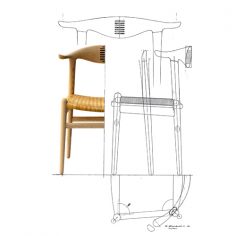
 In a film by Hanne Mynster, Wegner explained the reason the top trail of the Round Chair was not joined by two dowels in a butt joint was that there was a chance a gap in the joint might appear if the two pieces of wood worked at cross-purposes. He must also have believed it possible to make a blunt vertical joint that was strong and beautiful. read more>>
In a film by Hanne Mynster, Wegner explained the reason the top trail of the Round Chair was not joined by two dowels in a butt joint was that there was a chance a gap in the joint might appear if the two pieces of wood worked at cross-purposes. He must also have believed it possible to make a blunt vertical joint that was strong and beautiful. read more>>
PP250 The Valet Chair (1953)

 Normally it is a cardinal rule for Wegner’s chairs that they are functional, which first and foremost means they must be good to sit on. However. There is an exception to this rule. PP250, or the Valet Chair. (Its Danish name is ‘Jakkens Hvile’, which in direct translation means ‘The jacket’s Rest’.) Of Wegner’s more than 500 chair designs, it is probably the one that demands the most practice and determination to sit on. read more>>>
Normally it is a cardinal rule for Wegner’s chairs that they are functional, which first and foremost means they must be good to sit on. However. There is an exception to this rule. PP250, or the Valet Chair. (Its Danish name is ‘Jakkens Hvile’, which in direct translation means ‘The jacket’s Rest’.) Of Wegner’s more than 500 chair designs, it is probably the one that demands the most practice and determination to sit on. read more>>>
PP502 The Swivel Chair (1955)
 The idea of designing office furniture was not alien to Wegner when he created the iconic Swivel Chair (PP502) in 1955. The installation of office furniture accounted for a sizable portion of the work he did for prominent architects Erik Møller and Arne Jacobsen in fitting out Århus Town Hall in the early 1940s. read more>>
The idea of designing office furniture was not alien to Wegner when he created the iconic Swivel Chair (PP502) in 1955. The installation of office furniture accounted for a sizable portion of the work he did for prominent architects Erik Møller and Arne Jacobsen in fitting out Århus Town Hall in the early 1940s. read more>>
CH401 The Airport Chair (1958)
CH401 distinguishes itself by being a modern and minimalistic chair that is easy to get up from, making it well suited as an easy chair in public buildings. This was also the case when its variant, AP39, was purchased by Copenhagen’s Kastrup Airport giving the chair its name The “Kastrup” or Airport Chair, the latter being the name Wegner himself chose to use. read more>>
EJ100 The Ox Chair (1960)

 In 1988, Erik Jørgensen was contacted by Hans J. Wegner, who had designed the Oxchair in 1960. The Ox- chair is one of the most challenging chairs to upholster, and that is exactly why Wegner came to Erik Jør- gensen. With his upholstery expertise, Erik Jørgensen was able to produce the chair, and it was launched in 1989 at the international furniture fair in Milan. In 1960, Wegner designed a feminine counterpart to the Oxchair, the Queen chair, which went into production in 2010. read more>>
In 1988, Erik Jørgensen was contacted by Hans J. Wegner, who had designed the Oxchair in 1960. The Ox- chair is one of the most challenging chairs to upholster, and that is exactly why Wegner came to Erik Jør- gensen. With his upholstery expertise, Erik Jørgensen was able to produce the chair, and it was launched in 1989 at the international furniture fair in Milan. In 1960, Wegner designed a feminine counterpart to the Oxchair, the Queen chair, which went into production in 2010. read more>>
JH513 Conference Chair (1960)


Wegner contributed to the Cabinet Makers Guild Exhibitions every year apart from 1940 since 1938. The exhibitions ended in 1966 and Wegner’s final contribution together with Johannes Hansen included a magnificent Boat Shaped Table JH713 together with JH 513 Conference Chair that they had first exhibited in 1960.
PP518 The Bull Chair (1961)

The Bull chair has four slightly diverging legs with stretchers between them, and a curved woven cane seat. Its top rail is made of two pieces of wood, joined in the middle of the back with six contrasting tenons. Wegner didn’t like concealing his construction solutions. If they exhibited good artisanship, they were likely to be beautiful in themselves and therefore should not be hidden from view. read more>>
CH36 Shaker Style Dining Chair (1962)

The dining room chair, CH36, was the first in a long series of Shaker inspired chairs that Wegner designed for Carl Hansen & Son throughout the 1960s. The Shaker, a religious sect in the United States, comprising of northern European immigrants had since the beginning of the 19th century have lived in small communities. read more>>
CH07 The Three Legged Shell Chair (1963)

The three-legged shell chair was unveiled at the Cabinet Makers Guild annual exhibition in 1963. A development of his ideas for the 1948 Museum of Modern Art completion for Low Cost Furniture the Three Legged Chairs were praised for their technical competence but criticised for their bulk and cost of production. Johannes Hansen produced a dozen chairs in 1989 to mark Wegner’s 75 th birthday. It was not until 1998 that it was put into full scale prodction by Carl Hansen and Son. read more>>
CH44 Shaker Style Easy Chair (1965)

The same ascetic expression found in CH36 is also evident in CH44. While one sits on CH36 for a specific purpose, one chooses to sit on the CH44 to rest and relax. Unlike CH36, CH44 is sturdier in appearance, setting it apart from the Shaker chairs, yet it has the same four characteristic rails in the back. It comes with matching seat and back cushions to further enhance sitting comfort. read more>>
PP701 The Minimal Chair (1965)

In 1965, after Wegner had finished building a new house for himself and his family just north of Copenhagen in Gentofte, he exhibited what the press called ‘an exceptionally elegant little chair’ at the Cabinetmaker Guild Exhibition, for which he received a 1,000-kroner exhibitor’s award. At the time he considered using it as a dining room chair in his new home, possibly in a wooden-leg version. read more>>
PP135 The Hammock Chair (1967)

The Hammock Chair (PP135), a modern version of the chaise longue, was a type of furniture Wegner occasionally revisited. read more>>
PP201 The First PP Møbler Chair (1969)
 While PP Møbler had been collaborating with Wegner since 1953, providing AP Stolen with the wooden frame for the Teddy Bear Chair, the firm did not work directly with Wegner until 1969 when he designed PP201. read more>>
While PP Møbler had been collaborating with Wegner since 1953, providing AP Stolen with the wooden frame for the Teddy Bear Chair, the firm did not work directly with Wegner until 1969 when he designed PP201. read more>>
The Ferry Chair (1975)
 There is a certain kinship between PP201. Both are simply constructed, strong armchairs with a the special back detailed in dark wenge used both as a decorative detail and a functional device to harmonise the appearance of a number of chairs when grouped together. read more>>
There is a certain kinship between PP201. Both are simply constructed, strong armchairs with a the special back detailed in dark wenge used both as a decorative detail and a functional device to harmonise the appearance of a number of chairs when grouped together. read more>>
GE460 The Butterfly Chair (1975)

 The Butterfly Chair (GE460) is a visual detour in Wegner’s oeuvre, and the many small models that were used for preliminary studies reveal a development process with a number of steps along the way. The chair is actually related to Wegner’s shell chairs, and like the Three Legged Shell Chair CH07 has removable upholstered pads mounted onto the seat and back shells. read more>>
The Butterfly Chair (GE460) is a visual detour in Wegner’s oeuvre, and the many small models that were used for preliminary studies reveal a development process with a number of steps along the way. The chair is actually related to Wegner’s shell chairs, and like the Three Legged Shell Chair CH07 has removable upholstered pads mounted onto the seat and back shells. read more>>
PP112 The Newspaper Chair (1978)
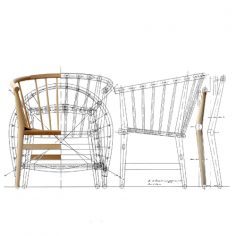
 Designed for the craftsmen at PP Møbler PP112’s low seat makes it well suited to lounges, lobbies and other waiting areas where the sitter can find momentary refuge protected within its relatively high circular spindle back. read more>>
Designed for the craftsmen at PP Møbler PP112’s low seat makes it well suited to lounges, lobbies and other waiting areas where the sitter can find momentary refuge protected within its relatively high circular spindle back. read more>>
GE201 The People’s Chair (1985)

 GE201, also known as ‘the People’s Chair’ was first presented at the Furniture Fair in Copenhagen’s Bella Centre in May 1982 and was the result of a long development process. The chair initially numbered GE601m is a simplified version of an earlier model GE525. read more>>
GE201, also known as ‘the People’s Chair’ was first presented at the Furniture Fair in Copenhagen’s Bella Centre in May 1982 and was the result of a long development process. The chair initially numbered GE601m is a simplified version of an earlier model GE525. read more>>
PP124 Rocking Chair (1984)

After all the attention his Hammock Chair (GE135) received in 1967, Wegner wanted to use the attractive hammock-weave pattern again, and the following year he designed a sturdy lounge chair consisting of large sections of solid timber that contrast with the almost spider-web-light flag halyard back. Called the Web Chair it is currently produced by PP Møbler as their model pp 129. read more>>
PP130 The Circle Chair (1987)

The workshop of PP Møbler was where Wegner went in the 1980s to experiment and work on concrete models of new designs. It was here one day that he mentioned his old idea of making a large circular lounge or easychair, but since he envisioned it being made of steel, it was not an assignment the cabinetmakers at PP could help him with. As it turned out, neither of these things came to pass. Wegner succeeded in converting his design from steel to wood, and PP Møbler succeeded in producing a functional wooden ring. read more>>
PP68 The Final Chair (1987)
 In 1987 aged 73 years old Hans J. Wegner designed his final dining chair and was determined to let all the versions of the design be guided by all he had learnt from his previous works. read more>>
In 1987 aged 73 years old Hans J. Wegner designed his final dining chair and was determined to let all the versions of the design be guided by all he had learnt from his previous works. read more>>
PP51/3 The V Chair (1988)


Between 1952-53 Wegner designed his two most famous three-legged chairs, the Valet Chair and Heart Chair. When he returned to the theme in 1988 the result was a very different looking chair that was not equipped with a top rail, but rather a beautifully designed V-formed backrest. When viewed from behind the beautifully detailed joint where the half free-floating frame that meets the ‘V’ is visible.
PP240 The Conference Chair (1989)

In 1989, at the age of seventy-five, Wegner was still able to design a conference chair that reminded the body of what optimal sitting comfort really is. Wegner had routinely designed conference chairs ever since the early 1940s when he was designing furnishings for Århus Town Hall. At the time he was inspired by a Spanish chair upholstered with loose fitting leather covers, an idea that is reflected in PP240, although here both the upholstered. read more>>












